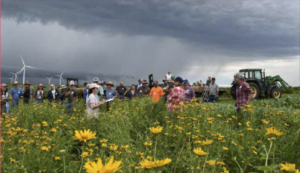Getting into Soil and Water 2020

Although farming is essential for providing food and fiber for society, farming practices can often come with unintentional environmental costs. While farmers do not wish to deliberately contribute to the degradation of natural resources, the current dominant system
of agricultural production in the Midwest has resulted in considerable soil erosion, substantially impaired water and air quality, and dramatically decreased wildlife and pollinator habitat. Fortunately, a large suite of conservation practices has been developed through years of cooperative research between universities and farmers to address these environmental concerns.
Such practices include things like cover crops, no-till farming, terraces, grassed waterways, prairie strips, diverse crop rotations, and stream buffers. While significant progress has been made over the past several decades, farmers on the whole have not yet voluntarily adopted these practices at a rate necessary to adequately balance agricultural production with natural resource sustainability throughout the Midwest. Understanding how and why farmers make decisions, including what factors influence the decision making process, is key for natural resource professionals to develop strategies for increasing the rate of farmer adoption of conservation practices.
Rural sociologists and other social scientists have been studying farmer behavior since the Dust Bowl era of the 1930s. One of the most important findings from this research has been that farmers are an incredibly diverse group of people with a wide array of beliefs, motivations, attitudes, values, and social norms that influence their behavior in very complex ways. This means that there is no singular strategy that natural resource professionals and policy makers are able to use to help encourage farmers to adopt conservation practices on their land. That being said, two recent projects led by researchers at Iowa State University and Purdue University analyzing decades of research studies have identified a number of factors that have most consistently been found to have an influence on adoption.
These meta-analysis research papers found that in general, farmers with larger farm sizes and income, farmers with higher levels of formal education, younger farmers, and those with farmland more vulnerable to erosion were more likely to adopt conservation practices. Additionally, farmers that identify with an environmental stewardship ethic, those who actively seek information about conservation practices, those who have previously adopted a practice, and those who have influential conservationist farmer leaders within their communities are more likely to adopt conservation practices.

Cost-share programs provided by state and federal agencies that help farmers pay for part of the cost of conservation practices have a positive influence on adoption. However, farmer awareness of these programs, as well as having positive attitudes about the programs themselves and the practices they pay for, are key to the amount of influence these programs have. Farmers who interact with natural resource professionals through conservation networks and programs are also more likely to adopt conservation practices. My own research has found a correlation between how often a farmer visits their local USDA office for conservation assistance and the likelihood that they will adopt certain conservation practices.
When considering the factors that influence farmers’ decisions, it is crucial to understand that farming is an enterprise that involves very high risks, and farmers often operate on extremely thin profit margins. The ISU and Purdue research teams identified several common barriers associated with risk that have a negative influence on adoption of conservation practices. The financial cost of practices, perceived reduction in crop yields, practice compatibility with existing farming practices, market fluctuations in crop prices, distrust of community or government agencies, neighbors’ lack of success with practices, complicated program application processes, and farmer uncertainty about potential practices can all decrease the likelihood that a farmer will adopt conservation practices.
Based on these findings, the authors of the two meta-studies also included several recommendations for natural resource professionals who work with farmers. Identifying and collaborating with farmer leaders in rural communities to facilitate conservation social norms through workshops and field days can be highly influential on other farmers. Increasing awareness by educating farmers about the benefits and potential risks, as well as how conservation practices can reduce risk, decreases uncertainty and can therefore increase adoption. Assisting farmers with cost- share programs helps offset financial risks, and accentuating other farmers’ positive experiences with adoption can be especially effective. Finally, one of the most important factors that influences farmers to adopt conservation is facilitating the development of long-term relationships and opportunities for knowledge transfer between natural resource professionals and farmers and between farmers themselves!
Chris Morris
Graduate Research Assistant Sustainable Agriculture and Rural Sociology, Iowa State University